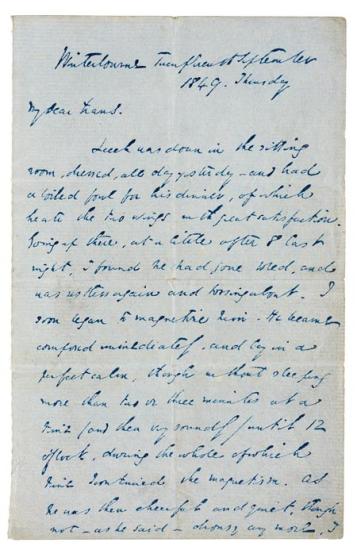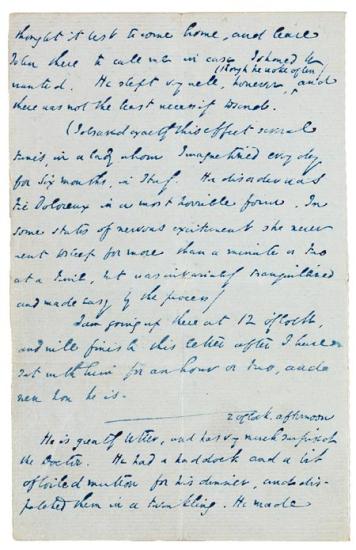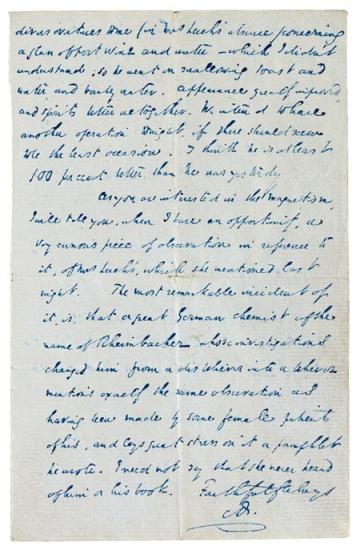Letter 16 | 27 September 1849 | to F. M. Evans, page 1

Autograph letter signed with initials, Winterbourne, 27 September 1849 to the publisher F. M. Evans
Purchased on the Fellows Fund, 1971
In 1849 John Leech, illustrator of A Christmas Carol, was injured in a swimming accident. In this letter Dickens reports using hypnotism to restore Leech's health: "I soon began to magnetize him. He became composed immediately, and lay in a perfect calm." Dickens was convinced of the therapeutic effect of his efforts on this occasion and recalled observing "exactly this effect several times, in a lady whom I magnetized every day for Six months, in Italy [Madame de la Rue]. Her disorder was tic Doloreux [trigeminal neuralgia, a severe, stabbing pain to one side of the face] in a most horrible form. In some states of nervous excitement she never went to sleep for more than a minute or two at a time, but was invariably tranquillized and made easy by the process."
Mesmerism
In his life and art, Dickens worked energetically for healing. His fiction exposed many of the social ills of his day, and a significant portion of his later journalism is devoted to an impassioned campaign to improve sanitation and public health. Although he was a committed evolutionist and progressive in his attitude toward science and the improvements wrought by technological advances, he was also, by imagination and temperament, attracted to the fantastic and pseudoscientific. This was manifested in his interest in spontaneous combustion and phrenology as well as his fervent belief and active experiments in mesmerism (or "animal magnetism"), an early type of hypnotism.
Dickens was introduced to mesmerism through Dr. John Elliotson, his family physician and one of his "most intimate and valued friends." He became convinced of the therapeutic effects of mesmerism after witnessing Elliotson's demonstrations in 1838, and, although there is no record of Dickens undergoing the procedure, he learned to mesmerize others. Throughout the 1840s, he conducted mesmeric experiments on his wife and friends.
My Dear Evans.
Leech was down in the sitting room, dressed, all day yesterday—and had a boiled fowl for his dinner, of which he ate the two wings with great satisfaction. Going up there, at a little after 8 last night, I found he had gone to bed, and was restless again and tossing about. I soon began to magnetize him. He became composed immediately, and lay in a perfect calm, though without sleeping more than two or three minutes at a time (and then very soundly) until 12 o'Clock, during the whole of which time I continued the magnetism. As he was then cheerful and quiet, though not—as he said—drowsy any more, I
Letter 16 | 27 September 1849 | to F. M. Evans, page 2

Autograph letter signed with initials, Winterbourne, 27 September 1849 to the publisher F. M. Evans
Purchased on the Fellows Fund, 1971
In 1849 John Leech, illustrator of A Christmas Carol, was injured in a swimming accident. In this letter Dickens reports using hypnotism to restore Leech's health: "I soon began to magnetize him. He became composed immediately, and lay in a perfect calm." Dickens was convinced of the therapeutic effect of his efforts on this occasion and recalled observing "exactly this effect several times, in a lady whom I magnetized every day for Six months, in Italy [Madame de la Rue]. Her disorder was tic Doloreux [trigeminal neuralgia, a severe, stabbing pain to one side of the face] in a most horrible form. In some states of nervous excitement she never went to sleep for more than a minute or two at a time, but was invariably tranquillized and made easy by the process."
Mesmerism
In his life and art, Dickens worked energetically for healing. His fiction exposed many of the social ills of his day, and a significant portion of his later journalism is devoted to an impassioned campaign to improve sanitation and public health. Although he was a committed evolutionist and progressive in his attitude toward science and the improvements wrought by technological advances, he was also, by imagination and temperament, attracted to the fantastic and pseudoscientific. This was manifested in his interest in spontaneous combustion and phrenology as well as his fervent belief and active experiments in mesmerism (or "animal magnetism"), an early type of hypnotism.
Dickens was introduced to mesmerism through Dr. John Elliotson, his family physician and one of his "most intimate and valued friends." He became convinced of the therapeutic effects of mesmerism after witnessing Elliotson's demonstrations in 1838, and, although there is no record of Dickens undergoing the procedure, he learned to mesmerize others. Throughout the 1840s, he conducted mesmeric experiments on his wife and friends.
thought it best to come home, and leave John there to call me in case I should be wanted. He slept very well, however, (though he woke often) and there was not the least necessity to send.
(I observed exactly this effect several times, in a lady whom I magnetized every day for Six months, in Italy. Her disorder was tic Doloreux in a most horrible form. In some states of nervous excitement she never went to sleep for more than a minute or two at a time, but was invariably tranquillized and made easy by the process.)
I am going up there at 12 o'Clock, and will finish this letter after I have sat with him for an hour or two, and seen how he is.
———
2 oClock. afternoon
He is greatly better, and has very much surprised the Doctor. He had a haddock and a bit of boiled mutton for his dinner, and dispatched them in a twinkling. He made
Letter 16 | 27 September 1849 | to F. M. Evans, page 3

Autograph letter signed with initials, Winterbourne, 27 September 1849 to the publisher F. M. Evans
Purchased on the Fellows Fund, 1971
In 1849 John Leech, illustrator of A Christmas Carol, was injured in a swimming accident. In this letter Dickens reports using hypnotism to restore Leech's health: "I soon began to magnetize him. He became composed immediately, and lay in a perfect calm." Dickens was convinced of the therapeutic effect of his efforts on this occasion and recalled observing "exactly this effect several times, in a lady whom I magnetized every day for Six months, in Italy [Madame de la Rue]. Her disorder was tic Doloreux [trigeminal neuralgia, a severe, stabbing pain to one side of the face] in a most horrible form. In some states of nervous excitement she never went to sleep for more than a minute or two at a time, but was invariably tranquillized and made easy by the process."
Mesmerism
In his life and art, Dickens worked energetically for healing. His fiction exposed many of the social ills of his day, and a significant portion of his later journalism is devoted to an impassioned campaign to improve sanitation and public health. Although he was a committed evolutionist and progressive in his attitude toward science and the improvements wrought by technological advances, he was also, by imagination and temperament, attracted to the fantastic and pseudoscientific. This was manifested in his interest in spontaneous combustion and phrenology as well as his fervent belief and active experiments in mesmerism (or "animal magnetism"), an early type of hypnotism.
Dickens was introduced to mesmerism through Dr. John Elliotson, his family physician and one of his "most intimate and valued friends." He became convinced of the therapeutic effects of mesmerism after witnessing Elliotson's demonstrations in 1838, and, although there is no record of Dickens undergoing the procedure, he learned to mesmerize others. Throughout the 1840s, he conducted mesmeric experiments on his wife and friends.
divers overtures to me (in Mrs. Leech's absence) concerning a glass of port wine and water—which I didn't understand; so he went on swallowing toast and water, and barley water. Appearance greatly improved, and spirits better altogether. We intend to have another operation tonight, if there should seem to be the least occasion. I think he is at least 100 per cent better than he was yesterday.
As you are interested in the Magnetism, I will tell you, when I have an opportunity, a very curious piece of observation in reference to it, of Mrs. Leech's, which she mentioned last night. The most remarkable incident of it, is, that a great German chemist of the name of Rheimbacher whose investigations changed him from a disbeliever into a believer mentions exactly the same observation as having been made by some female patients of his, and lays great stress on it [in] a pamphlet he wrote. I need not say that she never heard of him or his book.
Faithfully Always
CHARLES DICKENS